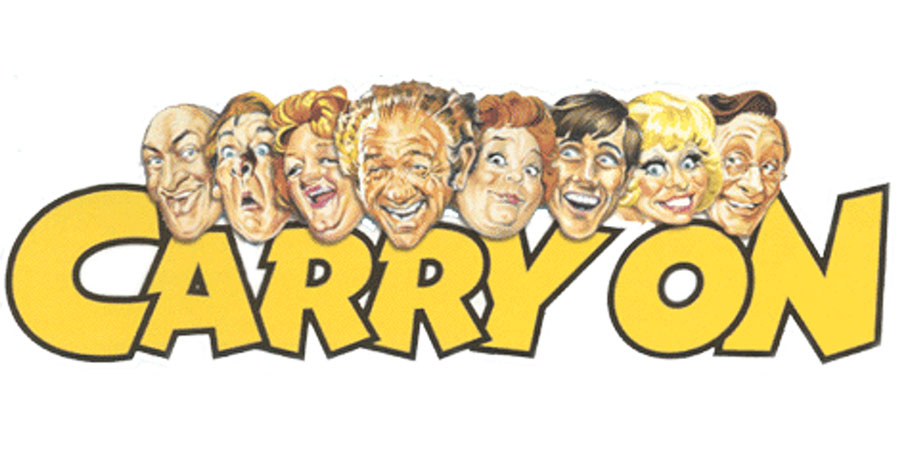
I didn’t grow up with the thirty-one films in the Carry On franchise. Although most Americans won’t have heard of them, the Carry Ons were a popular and long-running series of comedies grounded in mockery of authority, stock characters, and sexual innuendo. They were all made by the same producer, the same director, two writers, and largely the same cast. Alas I was born a bit late to enjoy them at the cinema. My earliest memory of them is catching a few minutes of Carry On Jack on TV, the scene where Kenneth Williams is threatening to throw the book at Bernard Cribbins, then actually picks up a book and throws it at him. I didn’t know what it was at the time and turned it off. Since then they’ve become one of my go-to favourites, much to the annoyance of my partner.
I just finished reading Steven Gerrard’s The Carry On Films (2016), a book that evolved from a doctoral thesis giving a historical and critical interpretation of the films. The book has been valuable to me for some details of the films’ context and some interesting interpretations of their themes. I can’t say I agree with all of Gerrard’s work, but it made interesting reading. The big issue, though, is the way Gerrard glosses over the fact that the films are unapologetically racist, sexist, and homophobic. I still love them and think they deserve to be loved for all the things they get right, but I’m also uncomfortably aware of the many things they get wrong. Gerrard is satisfied to sweep these under the rug by saying that the films’ “embroidered and blatant stereotyping remain far too exaggerated for them to be considered as anything but inoffensive, harmless entertainment.” (Gerrard, 2016, p. 51) Sorry, but that doesn’t quite fly with me. Sit down with a Black friend and watch Carry On Up the Jungle, which features white actors in blackface, and tell me that you’re not uncomfortable. With a gay friend watch Carry On Abroad, which features an exceptionally unpleasant, bitchy queen, and tell me you’re not uncomfortable. With a woman friend watch Carry On Girls, which features a bikini’d catfight, bras springing open, and an antagonist called Augusta Prodworthy, and tell me you’re not uncomfortable. Yes, the comedy is ridiculously over-the-top, but I don’t find it so easy to excuse the films’ treatment of anyone who isn’t straight, white, and male. I want to analyse (though not excuse) those discriminatory depictions here. Anyone who enjoys old films has to do a certain amount of hedging because a movie made a hundred years ago is never going to conform to the political and social standards of today. That doesn’t mean they don’t have their own merits but it does mean the onus is on us to acknowledge the bad as well as the good.
Homophobia
I’ll start with gay men because this is really the only one where I can claim to be a part of the maligned group. The treatment of gays and women also differ in a key way from the treatment of people of colour, so I’ll get to the racism last.
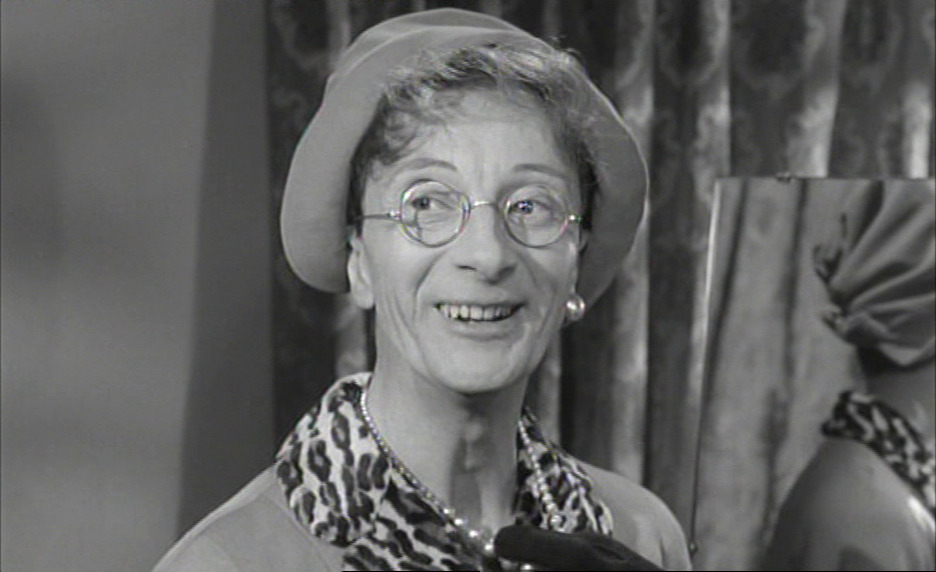
Image credit: Carry On Constable
The gay actors of the Carry On franchise are of course Charles Hawtrey, Kenneth Williams, and Frankie Howerd, all of whom the series used to great effect to play outrageously camp characters. Effeminacy and homosexuality in the films is inevitably a source of comedy and often, though not always, ridicule. Charles Hawtrey, being so elfin and sexless, often gets away with a pixie-like role that’s funny without being mocked outright. He can be seen in this light right from the start in Sergeant and in others like Cabby and Up the Khyber. In the beginning Kenneth Williams was cast in a similar light. His character in Sergeant is effete but not a raging gay stereotype. Later, however, Williams’ snide and haughty delivery earned him more authoritarian roles where his authority is undermined by his effeminacy (Matron, Camping). Here he’s playing high camp, and his coded homosexuality is used to depict him as un-masculine. Howerd, although only in two of the films, plays a Williams-type character — an authority figure who is rendered ridiculous by his effeminacy.
For the straight men in the audience, the joke is simple: un-manly men are funny. For the gay men in the audience, the joke has other dimensions. Hawtrey and Williams were playing gay at a time when homosexuality was illegal in England. Williams even used Polari, the underground language of gay men, which afforded them some protection from being overheard or understood by the police. Being in the Carry On films allowed them to be outrageously camp on-screen in a way they weren’t allowed to be in real life (Gallagher, 1998; Healy, 1995).
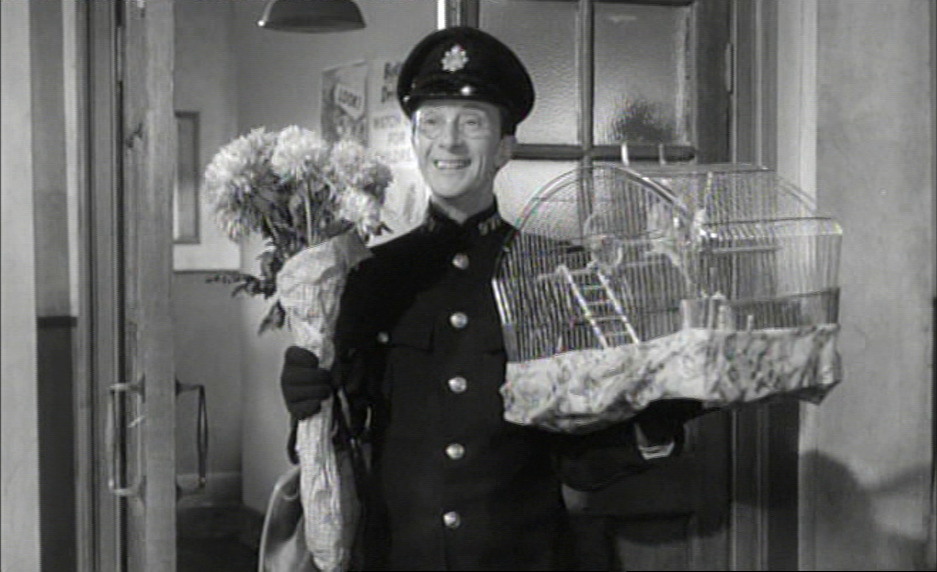
Image credit: Carry On Constable
Healy (1995) adds that Williams and Hawtrey “would be able to transmit queer messages, while performing within the constraints of heterosexual narratives, ironically mimicking straight expectations while pointing to an alternative reading — in other words, the tactic of camp.” This has certainly been my reading of them. Their characterisations often undermine heterosexual authority figures, such as in Sergeant and Spying, because the usual constraints of masculinity don’t apply to them. Hawtrey can mince into the police station in Constable with a big bouquet of flowers and instantly demolish Sid James’ po-faced heterosexuality. When Williams expresses horror at the female form in Camping (both Barbara Windsor’s and Hattie Jacques’), the straight audience sees a laughable figure who wouldn’t know what to do with a woman if he got one, but the gay male audience sees a character who, like themselves, is utterly uncharmed by the supposed appeal of women’s bodies — a rejection of heterosexual norms. Although Williams in Camping is still a laughably ineffectual authority figure, he’s also our gay hero who isn’t afraid to reject what other men want.

Image credit: Carry On Camping
The worst display of homophobia in the Carry Ons, however, is John Clive’s character Robin in Abroad. Robin is nothing more than a bitchy queen who’s there to get rejected. It’s an exceptionally nasty characterisation that, unlike Hawtrey’s and Williams’ characters, only punches down. It’s the Carry Ons at their worst, and there’s little that can be said in Robin’s defence.

Image credit: Carry On Spying
Although they depicted gay men more often, the Carry Ons did make a couple of forays into lesbianity. Dr Crow in Spying is never explicitly called out as a lesbian but is clearly coded that way. The joke about Crow’s character is that they’re really a hermaphrodite. Explaining homosexuals as having been born in the wrong body or being a mix of male and female has always been cheap and reductive, but outside of that I can’t find much about their character to dislike. They’re an ingenious Bond-style villain who’s more than capable of running circles around the incompetent British spies. Lesbian viewers might read Crow differently, but as far as I can tell they’re a bit iconic! I’ll add Rosemary from Girls to the list of lesbian representation. Yes, they do the cheap joke that she dresses like a man, but time has largely defanged that joke. Rosemary could dress that way today without raising an eyebrow. Frost (2022, p. 184) describes her as “Carry On’s only representation of camp-free gender fluidity.”
Sexism
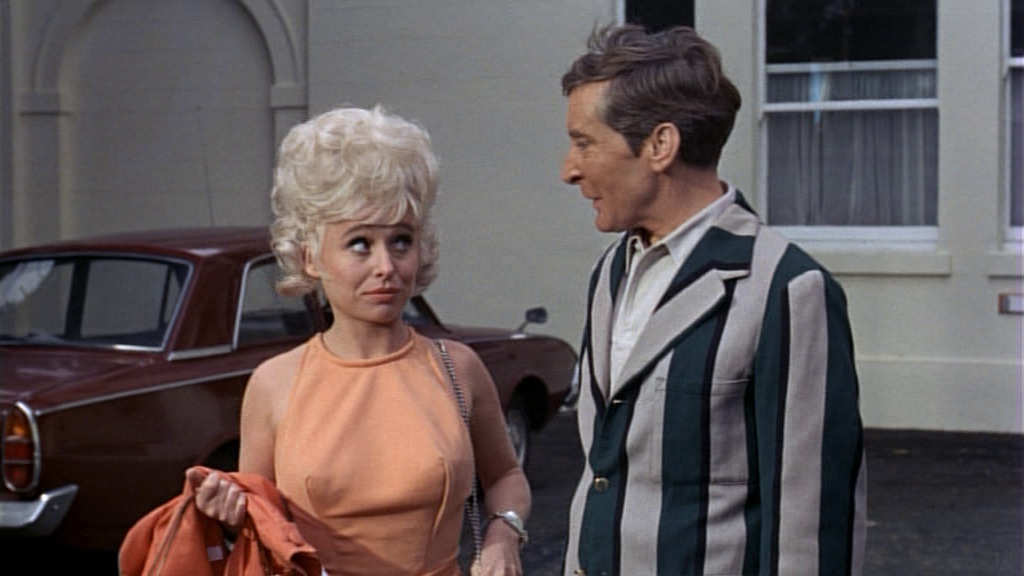
Image credit: Carry On Camping.
Women get an extremely unfair treatment in the Carry On films. Even in earlier entries in the series they are still the object of affection in a way that the men are not. Teacher, say, has one of Joan Sims’ best roles in the franchise, where she is depicted as strong, capable, and attractive, and she still gets a suggestive name like Allcock and has her pants split down the middle. Male nudity, on the other hand, such as the policemen’s bare bottoms in Constable, is never a source of titillation (Jordan, 1983, p. 321). From Miss Allcock the sexualisation of women only gets worse until we’re left with Barbara Windsor’s sexpots and dolly birds in the later films. Women are always subject to the male gaze in Carry On films and there is little to no female gaze.
When they stop being young and slim, the women of the Carry Ons become “middle-aged harridans” and “nagging wives” (Jordan, 1983, p. 321). Jordan goes on to say that “the most objectionably cruel of the stereotypes of the unattractive woman is that of the aging (or in some other way non-pin-up) spinster, aping a coy girlishness in the hope of catching a man.” This role most often goes to Hattie Jacques who always carries it of with aplomb but I can never help cringing at how her comic talents are repeatedly squandered on playing cheap fat-woman stereotypes. It’s no coincidence that one of the best Carry Ons is Cabby, where Jacques gets to play the sympathetic protagonist who gets the better of her petty, neglectful husband. It’s the kind of role I’d like to have seen her in a lot more often.
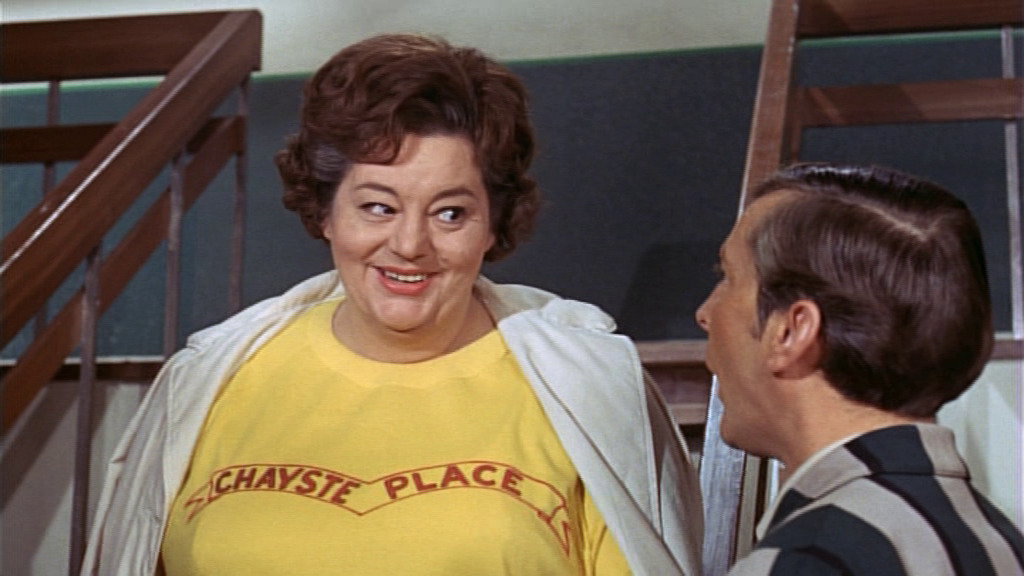
Image credit: Carry On Camping.
Gerrard (2016, p. 110–114) makes the case that although the women of the Carry Ons are highly stereotyped one way or another, they remain independent, strong-willed, and superior to the men around them. In this way, then, the women can be seen to undermine the stereotypical roles they’re given. I don’t quite buy Gerrard’s argument because the depiction of women as superior is a cheap fetishisation of women that puts them on a pedestal. Marking women out as superior is still othering them from men and making them the object of male desire. What’s more, the characterisation of women as superior comes from the scripts, not from the actors themselves. Actors like Windsor, Jacques, and Sims don’t get their own chance to undermine conventional notions of sexuality and gender roles in the same way that the gay men use their performances to send their own coded signals.
Caroline Frost (2022, p. 177–186) provides a much-needed female perspective and makes a case that the women’s roles are empowering rather than demeaning. She adds comedian Meryl O’Rourke’s opinion that what looks like sexism is in fact sex positivity and reflected the social movement of women taking charge of their sexuality: “Girls was one of the films blowing the doors off.” (Frost, 2022, p. 184)
The female roles are, at the very least, still played by women, so we can assume some level of buy-in or approval from the actresses. Indications are that the women involved were treated well and did not object to their roles (Frost, 2022, p. 178, 181). The same can’t be said of the non-white roles in the series.
Racism
“I imagine they think it’s appropriate.”
— Kenneth Williams on being cast as the Khasi of Kalabar
(Williams, 1993, 320).
The Carry On films’ least excusable caricature is that of people of colour. There are no actors of colour that I’m aware of in these films, yet we have Kenneth Williams as an Indian and Bernard Bresslaw as an Afghan in Up the Khyber, Charles Hawtrey as a Native American in Cowboy, Bresslaw as an African in Up the Jungle and again as an Arab in Follow That Camel. We can’t rationalise away these depictions. The best we can do is put them in context as just another in a long line of performances of others that the English seem to find so funny.
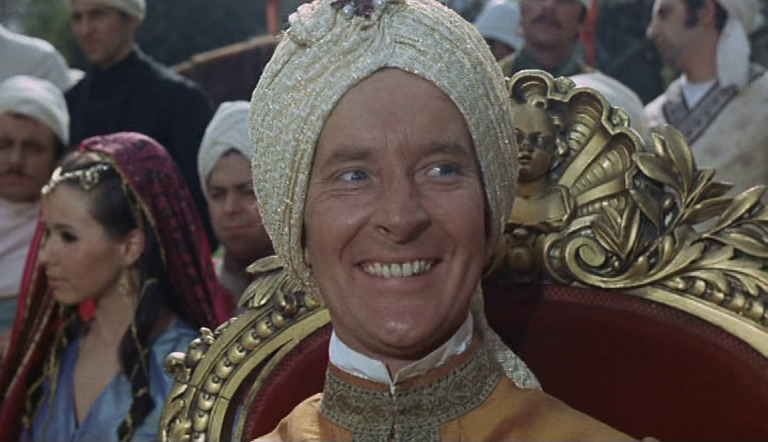
Image credit: Carry On Up the Khyber.
England has a long tradition of laughing at a recognisable face in an outlandish get-up. Soldiers used to do drag to entertain their comrades (as Hawtrey says as he drags up in Constable, “Do you know, I haven’t done this since I was in the army at a camp concert.”) Spying, Don’t Lose Your Head, and Cleo all feature well-known faces in unlikely-looking drag. The English also extend the same principle to the clothing of other nationalities. To this day the English think it’s funny to dress as people from other cultures and make little joke beyond the fact that they’re wearing a style that belongs to someone else (Rao, 2022). The best case study I can think of is Peter Sellers, who played an Indian character in The Party (1968) and a Chinese character in Murder By Death (1976). These performances were intended for the same comic effect as putting him in drag in The Mouse That Roared (1959) or casting him in three different roles in Dr. Strangelove (1964). At least in Murder By Death the offensiveness of the portrayal was deliberate — Sellers is supposed to look unlikely because he’s parodying the bad yellowface in the Charlie Chan detective films.
The excuse of satire, however, does not apply to the Carry On films. The case has been made that a movie like Khyber is a satire on the crumbling British Empire (Frost, 2022, p. 96), but that doesn’t explain why brownface was used instead of, say, hiring Indian actors. The joke is as simple, tasteless, and offensive as seeing a familiar face in a wacky get-up. White audiences at the time would have seen Kenneth Williams as an Indian in much the same way they’d have seen him gussied up as Julius Caesar (Cleo) and Sid James as a cowboy (Cowboy). Non-white audiences, however, might not have taken the joke so lightly and I can only imagine how horrifying it would be for a Native American to see themselves depicted by Charles Hawtrey as a costumed, violent drunk (Cowboy).
In the case of sexuality, the gay characters are played by gay men. They have the opportunity to colour their performances in a way that both plays to and undermines heteronormative expectations. In the case of sex, the dolly bird objects of the male gaze are played by women who, it can be argued, bring a certain degree of empowerment to their roles. In the case of race, however, the people being caricatured are absent. The Carry On world is overwhelmingly white, possibly even entirely white as I’m struggling to remember a single actor of colour in the whole canon. People of colour, then, are the only ones the Carry On franchise entirely excludes.
Why Bother
In her critique of “The Talons of Weng-Chiang”, Doctor Who’s most racist outing, Elizabeth Sandifer (2013) wrote that it didn’t matter how clever the story is, the sheer nastiness of the racism cannot be glossed over in the name of entertainment:
The goal of amusement feels like a fig leaf to avoid confronting the political implications of the story, so that Holmes doesn’t have to worry about things like not perpetuating racist stereotypes or demeaning the working class. It’s all in good fun. He can just be clever and witty and everything will be good. Just like Baker can be. Just like the whole show can be. There’s an arrogance here that’s demoralizing. A sense of the show flying too close to the sun. A sense that it must be cast down.
All of that applies to the Carry On franchise — it doesn’t matter whether the films are clever, their gross offensiveness has to be called out. There are too many apologists who want to dismiss the nastier elements of the Carry Ons in the name of just having a bit of fun and dismissing critics as “the politically correct brigade” (Gerrard, 2016, p. 226). I hope I’ve done some of the work to call them out for those nasty elements and I encourage others to call them out from perspectives other than mine.
With that in mind, can the Carry Ons still be enjoyed for their other qualities? This will come down to your own taste. I watch a lot of old movies and have seen plenty of examples of racism, sexism, and homophobia in films from the 1910s through to the 1990s (and, I daresay, beyond). In general, unless the film is deliberately malicious, I’m able to see both the good and the bad and recognise the film in its context. It’s not a matter of the good outweighing or making up for the bad, but acknowledging what the film gets wrong at the same time as appreciating what it gets right. If you can find that balance in the Carry Ons then I think they have a lot to offer. If not then I wouldn’t blame you one bit, but for my part I want to take a moment to talk about what I get out of these films that’s important to me.
The Good
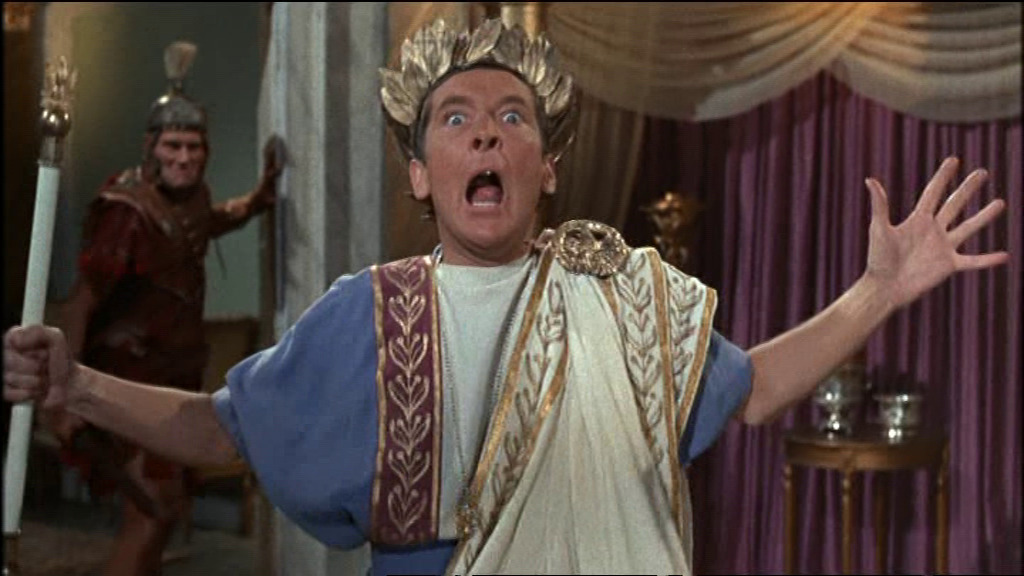
Image credit: Carry On Cleo
However many cringey, lame, and hopelessly fizzled jokes are in the Carry On films, there are still a wealth of good ones. I was hooked from the moment I heard about Kenneth Williams’ well-known one-liner in Cleo: “Infamy! Infamy! They’ve all got it in-for-me!” Since then I’ve come to love the films’ camp extravagance in all its forms from Hawtrey’s and Williams’ grotesquely over-the-top performances to the playful and cheesy sexual innuendo. I don’t care if it’s puerile, I will always love Charles Hawtrey’s elfin little “Oh hellooooo,” usually followed by some barely disguised innuendo like “Splendid girl, and so helpful. Do you know she’s been showing me how to stick the pole up.” (Camping) The simple fact is I just don’t see this kind of humour in modern movies or TV. I don’t see the suggestiveness, the cleverness, the sly, cheeky, good-natured innuendo, the camp sensibility, the delightful puns, and even all the tired references to “it” (sex). Jokes in popular media now aren’t unsubtle, they’re just different. They’re up-front and honest, usually single-layered rather than double entendre. They don’t sneak in through the backdoor (ooh er, matron!)
On the subject of camp sensibilities, it’s also the case that these movies from the 1950s and 1960s, even with their gross caricatures of gay men, still have better representations of homosexuality than a lot of modern movies. For a long time the effeminate stereotype was condemned as a “comic spectacle for the heterosexual audience” (Healy, 1995) and eventually banished from our screens. Hollywood will let you have gay characters now, but the correction has gone too far the other way — how often do you see gay characters this camp, this outrageous, this effeminate? American society has a horror of effeminacy; being gay is all right as long as you’re not too girly about it. I rebuke that and I relish seeing Hawtrey, Williams, and Howerd being as outrageously camp as they like. It’s a form of homosexual expression that is entirely absent from Hollywood fare and hard to find in any popular media outside of RuPaul’s Drag Race, and even there it’s just reality-TV bitchiness rather than scripted humour.
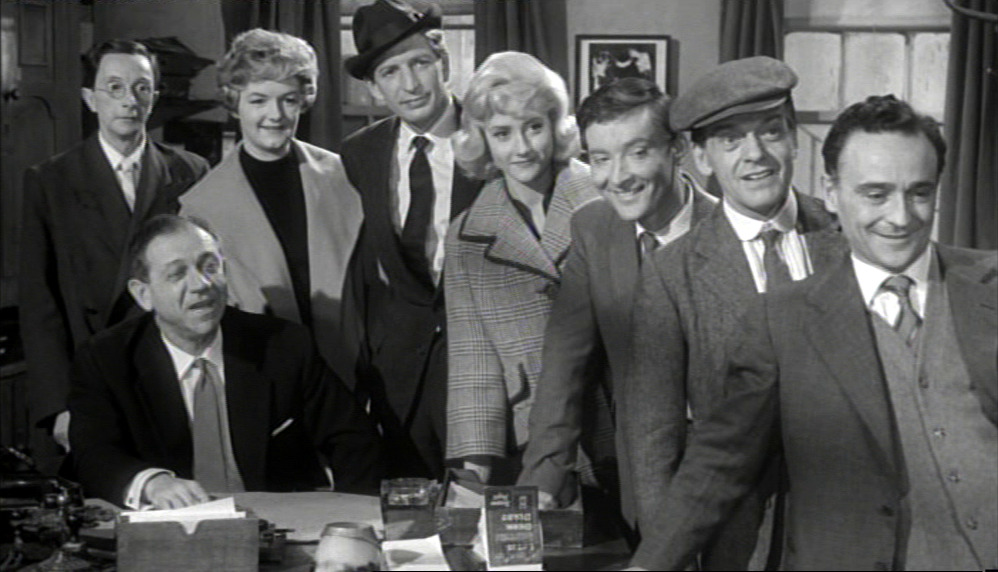
Image credit: Carry On Regardless.
Another factor is the familiarity of a Carry On film. Any serial like a sitcom, or a franchise like superhero movies, offers something that is comforting. You know you’re going to see familiar faces in familiar situations. These are people you like, people you empathise with, people who you choose to spend your time with. To a certain extent in our lizard brains, the people on the screen are almost like friends. When I switch on a Carry On film I get very much that same sense of comfort. I know who I’m going to see, I know I’m going to get some laughs, I know I’m going to see some innocently suggestive innuendo. The Carry On label is (with some notable exceptions later in the franchise) a guarantee of good times. Roland Barthes (1985), the French critic and philosopher and, it appears, closet Carry On fan, wrote:
On those occasions when I have happened to watch a Carry On film (not professionally as a critic; more idly, rather, precisely as a diversion from the exercise of criticism), I have experienced a similar sense of assurance, of social and, indeed, existential harmony, of ‘things in their place’. Though the extrinsic settings may vary with each film (barracks, hospital ward, grammar-school classroom; or else the Khyber Pass at the turn of the century, the ‘Merrie England’ of Henry VIII), the ‘world’ proposed to us remains a vacuum as finite and compact as the Nautilus, since it is founded, not on measurable boundaries, but on an unchanging interconnection of relationships between the company of performers and the stereotypes which, from film to film, from epoch to epoch, they never cease to embody.
There is, in other words, a comfortable and reliable escapism that allows us to enjoy “a game, a giggly, off-colour charade, a tiny microcosm of the adult world”.
Personally I also get some comfort from knowing something about the actors themselves. They were human too and had troubled lives of their own involving dangerous love affairs, self-destruction, depression, alcoholism, and failed ambition. I know I’m not the only one with a fascination for these actors’ lives because at least four biopics have been made about them, and that’s not counting the volumes of published diaries and biography. I like watching these people because they remind me that I’m not the only one with an imperfect life. It happens to the best of us.
I won’t judge you if the Carry Ons aren’t your speed. They are very different from movies today and, god knows, they have a raft of their own egregious flaws. It is absolutely necessary to acknowledge and understand those flaws rather than try to rationalise them away, but if you can live with them then I think the Carry On films offer more than enough by way of reward.
References
-
Barthes, Roland. (1985, Spring). The Nautilus and the nursery (Gilbert Adair, Trans.). Sight and Sound, 54(2), 130–132.
-
Frost, Caroline. (2022). Carry on regardless: Getting to the bottom of Britain’s favourite comedy films. White Owl.
-
Gallagher, Paul. (Director). (1998). Carry on darkly [Film]. Channel 4.
-
Gerrard, Steven. (2016). The Carry On films. Palgrave Macmillan. https://doi.org/10.1057/978-1-137-52005-0
-
Healy, Murray. (1995). Were we being served? Homosexual representation in popular British comedy. Screen, 36(3), 243–256. https://doi.org/10.1093/screen/36.3.243
-
Jordan, Marion. (1983). Carry on … follow that stereotype. In James Curran & Vincent Porter (Eds.), British cinema history (pp. 312–327). Weidenfeld and Nicolson.
-
Rao, Tejal. (2022, October 14). ‘Mexican Week’ was not an accident for ‘The Great British Baking Show’. The New York Times. https://www.nytimes.com/2022/10/14/dining/great-british-bake-off-mexican-week.html
-
Sandifer, Elizabeth. (2013). The lion catches up (The Talons of Weng-Chiang). In TARDIS eruditorum: An unofficial critical history of Doctor Who (Volume IV: Tom Baker and the Hinchcliffe Years). Eruditorum Press.
-
Williams, Kenneth. (1993). The Kenneth Williams diaries (Russell Davies, Ed.). HarperCollinsPublishers.